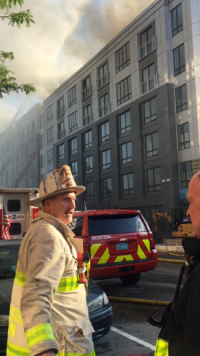July 27, 2017

A faulty exhaust pipe connected to a basement generator ignited flammable materials on the roofline of the Treadmark building on the afternoon of June 28, sparking a six-alarm fire that tore through the wood-framed building’s upper floors, according to Boston’s fire commissioner, who detailed the results of an extensive investigation on Wednesday.
BFD Commissioner Joe Finn also revealed that that signs of a possible fire were first detected by construction workers about an hour-and-a-half before the Boston Fire Department was notified, a long delay that Finn says likely made a bad situation far worse.
“It’s a grave concern,” said Finn of the lost time in a press conference at BFD headquarters, calling it “a total breakdown on the construction site itself.”
The structure comprised four stories of wood-framed construction over two floors of steel and concrete — a style that developers and city officials have emphasized is common throughout the city and very safe if built to code.
Workers were testing the building’s emergency generator in the basement that day. The generator exhaust pipe, which runs up through the top of the building, heats up from gases produced as the device is in use.
Finn and the city’s top building inspector— William ‘Buddy’ Christopher— said that the pipe should have had more clearance between its hot surface and flammable materials in the building. “We are confident in the area of origin in the space between the sixth floor and roof and that it was caused by exhaust piping from the emergency generator in the basement,” said Finn.
Just as an exhaust pipe on the back of a car running 70 miles per hour on a highway becomes scorching to the touch, the generator pipe can reach up to 800 degrees during heavy use and be hazardous near any potential tinder.
Another complicating factor was the sprinkler system. While sprinkler and life safety systems in the building were installed and operationally ready, they had not yet been turned on. Finn and Christopher each emphasized that there was no requirement that the sprinklers be activated at that time.
Treadmark, with 83 units including 32 condominiums and 51 affordable rental units, was scheduled to be inspected on June 29 — the day after the fire— for a certificate of occupancy. Christopher said that fire officials and inspectors likely would have spotted the flawed design of the exhaust pipe.
The top two floors, full of condominium units, had already been sold. Almost all of the apartments on the second through fourth floors were rented to income-eligible renters selected through a city lottery. The first wave of residents was set to move in on July 15.
The delay in calling 911 emerged as a key factor in determining the cause of the fire. Testing on the emergency generator unit, Finn said, started at 10:30 a.m. on the day of the incident, with the unit’s capacity steadily increased over the next several hours.
He said that witness reports on the scene indicate that an odor of smoke – and a haze— was first noticed by workers at about 1 p.m. But the fire department was not called to the scene until 2:30. “The call should have went to 911 and we could have found this fire in a short period of time,” remarked Finn, who said that firefighters could have used infra-red equipment to locate the source of the smoke. “We want the construction industry to understand that if there’s an odor of smoke or haze, they have to report it right away.”
Christopher said that city officials will review the fire department’s findings to discuss potential “recommendations” for protecting buildings under construction. “There was no legal requirement for that sprinkler system to be turned on because it was not occupied at that time,” said Finn. “The fact that it wasn't turned on is certainly a contributing factor here.”
Finn added: “Everyone thinks sprinkler systems are a panacea — they are not. They need to be functioning and operational.”
Said Christopher: “At this point, Joe's team has assessed what the cause was. Now it’s our responsibility to sit down and review that and see what steps make sense to have the safest buildings for construction workers and firefighters and residents.”
Christopher said that he did not expect any change to building codes. “We have absolute faith in our construction industry here in Boston. This is a case we will use to develop some standards, but no we don’t think it’s a systemic problem.”
Finn was more explicit about his concerns about the potential hazards of wood-framed buildings, especially for first responders. “I do have concerns with lightweight construction,” he said. “From a fire-fighting perspective, they are very dangerous to the people working in them in the construction phase. You see the potential for rapid-fire development.
Finn noted that the area where the pipe ignited the fire – the southwest corner of the roofline – collapsed just nine minutes after fire fighters arrived. “These are dangerous buildings in the construction phase,” he said.
The owners and developers of the Treadmark builing— Trinity Financial, Inc. – did not respond immediately to Finn’s assessment of the fire’s causes. However, the company’s leaders have said they do plan to rebuild, but have not yet determined whether a gut rehab of the building could preserve the existing shell, or if it would need to be stripped down to the concrete base and rebuilt entirely.
Work is ongoing to demolish the roof and top story, which sustained the most extensive damage. Those areas need to be cleared out along with any rooftop equipment for inspectors to safely assess the remainder of the building. Until they can access the fifth floor and take the measure of the structure, Trinity will not have a concrete plan for reconstruction.
News editor Jennifer Smith contributed to this story.
Villages:
Topics:
Tags:


